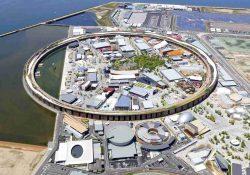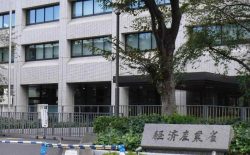Many Health Care Facilities Unprepared for Tsunami-Related Disasters; 40% Without Evacuation Plan

A coastal area in Kochi Prefecture where a tsunami up to 30 meters high is feared in the event of a Nankai Trough earthquake
1:00 JST, June 7, 2025
Despite concern over future earthquakes in places such as the Nankai Trough off Japan’s Pacific coast, health care facilities in tsunami disaster warning areas across the country have been slow to draw up plans to secure the safe evacuation of people, such as the elderly and hospital inpatients.
Drawing up evacuation plans is mandatory for health care facilities, such as hospitals and long-term care homes in areas that could be hit by tsunami. Yet 40% of them have not done so, according to a survey by the Land, Infrastructure, Transport and Tourism Ministry. This is due to staff shortages at such facilities and a lack of publicity about the obligation. The ministry is hoping to help them speed up the drafting of plans by sharing model cases already made by other municipalities.
Many factors to consider
The estimated damage caused by a Nankai Trough earthquake, which the government published in late March, includes a potential tsunami up to 34 meters high hitting Kochi Prefecture. In 2022, 19 coastal cities, towns and villages in the prefecture were designated as tsunami disaster warning areas. But only 35 facilities, or 26%, of the 133 health care facilities in those areas had drawn up evacuation plans as of the end of September last year.
One such facility in Kochi City may be flooded by tsunami up to 5 meters high, according to the government estimate. However, the facility is having trouble drafting a plan.
“Many of our patients cannot walk on their own. There are so many factors to anticipate and deal with, such as how to prepare for evacuation during the night and on holidays. We also need knowledge from experts, such as doctors and physiotherapists,” said an employee of the facility.
The new damage estimates by the government have increased the employee’s sense of crisis. “The quake can occur anytime. We’d like to swiftly work on drafting a plan,” they said.
“Publicity of the need for facilities to make plans is not sufficient in some municipalities,” said Naoto Fujimoto, an official at the Kochi prefectural government’s disaster medical response office. “The prefecture is ready to put forth greater efforts in encouraging them to do more.”
Understanding of need varies
An evacuation plan should include information such as where to evacuate and the routes to the shelter, as well as staff assignments and preparations made in case of disasters. Drawing up the plan is mandatory for facilities used by people with special needs, including health care facilities, schools and social welfare facilities, that are located within a tsunami disaster warning area and are included in the regional disaster prevention plan.
Among 1,284 health care facilities located in areas of Tokyo and 21 prefectures that may be affected by disasters such as a Nankai Trough quake, 772 facilities, or 60%, had finished drawing up plans, according to the latest ministry survey dated September last year. The percentage is low compared to schools (1,183, or 84%, of 1,404 had made plans) and social welfare facilities (6,635, or 75%, among 8,818 such facilities had done so).
Facilities in Hokkaido and the Tohoku region, where there are concerns of a Japan Trench earthquake and a Chishima Trench earthquake, are also notably slow to draft plans. The percentage of relevant municipalities in which facilities have done so is 39% in Hokkaido, 45% in Aomori Prefecture and 33% in Iwate Prefecture.
As for the reason for their delay, a ministry official in charge cited staff shortages at smaller facilities and added: “Medical and health care facilities vary in size and form, so their understanding of the need for plans also varies. Some of them don’t even grasp that making the plan is mandatory.”
Input form encourages planning
Some municipalities are preparing their own system to encourage those facilities to draw up plans.
In fiscal 2023, Shizuoka City independently developed an input form, which enables facilities to automatically make plans by inputting the necessary information. All 141 relevant facilities in the city, including social welfare facilities, completed drawing up the plans by fiscal 2024.
“Making the plan is not the end. We’d like to make thorough preparations, taking various possibilities into consideration, such as the potential extent of flooding,” said Yasushi Zaitsu, the head of Shizuoka Hirono Hospital Nursing Care Medical Clinic in Shizuoka City.

Yasushi Zaitsu, the head of Shizuoka Hirono Hospital’s nursing care medical clinic, about 400 meters from the sea, poses for a photo in Shizuoka.
The ministry is hoping to encourage municipalities that are lagging behind in making plans by sharing examples already made by other municipalities and offering training.
“The government should follow up with the municipalities not only in drawing up plans, but also in efforts to strengthen their preparations for receiving manpower and supplies so everyone can evacuate quickly,” said Masahiro Nemoto, a professor at the Japanese Red Cross Hokkaido College of Nursing who is well-versed in disaster prevention for people with special needs.
Some facilities not quake-resistant
There are quite a few hospitals and other health care facilities that are not sufficiently resistant to quakes.
A survey by the Health, Labor and Welfare Ministry in 2022 found that of 8,085 hospitals nationwide that responded, 1,660 hospitals, or 20.5%, said their buildings are either not quake-resistant (including part of the buildings) or their quake-resistance level is unclear. Those hospitals have not progressed in making their buildings quake-resistant for various reasons, such as being unable to afford construction fees or finding it difficult to arrange to transfer inpatients to other hospitals while seismic reinforcement work is done.
According to estimates of damages caused by a Nankai Trough earthquake released in March, there would be as many as 160,000 patients either seriously injured or in need of changing hospitals.
“If a health care facility is damaged by a tremor, it greatly affects medical treatment,” a ministry official said. “The government will continue to offer financial support so 100% of such facilities will become sufficiently quake-resistant.”
"Society" POPULAR ARTICLE
-

Tokyo Experiences Temperatures Exceeding 30 C for 1st Time This Year; Other Parts of Japan also See Soaring Temperatures
-

Japan’s Maglev Shinkansen’s Partially Completed Station Unveiled; Station Will Be Only Underground Stop Between Shinagawa, Nagoya
-

2025 Expo Osaka: Japan Pavilion Security Guard Headset Goes Viral on Social Media; Fans Delight at Similarity to Dragon Ball “Scouter”
-

2025 Expo Osaka: Yoshimura Asks Japan Expo Association to Consider Keeping Restaurants, Shops Open until Just before 10 P.M.
-

2025 Expo Osaka : Expo Venue Hit by Swarms of Chironomids; Organizers Cooperating with Pest Control Companies, Others to Deal with Outbreak
JN ACCESS RANKING
-

Toyoda to Become Automobile Business Association of Japan Chairman; to Help Guide U.S. Tariff-Affected Industriessns
-

Visitors to Japan Hit Single-Month Record High in April
-

Japanese Researchers Develop ‘Transparent Paper’ as Alternative to Plastics; New Material Is Biodegradable, Can Be Produced with Low Carbon Emissions
-

Japan to Introduce Car Fuel with Up to 10% Biofuels from Fiscal 2028; Limited Rollout Expected at Areas with Refineries
-

Japan’s Core Inflation Hits More than 2-year High, Could Force Year-End BOJ Hike




















